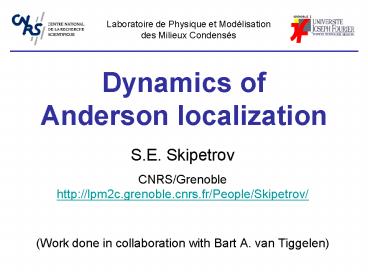Dynamics of Anderson localization PowerPoint PPT Presentation
Title: Dynamics of Anderson localization
1
Dynamics ofAnderson localization
Laboratoire de Physique et Modélisation des
Milieux Condensés
- S.E. Skipetrov
- CNRS/Grenoble
- http//lpm2c.grenoble.cnrs.fr/People/Skipetrov/
- (Work done in collaboration with Bart A. van
Tiggelen)
2
Multiple scattering of light
Incident wave
Detector
Random medium
3
Multiple scattering of light
Incident wave
Detector
l
l
Random medium
L
4
From single scattering toAnderson localization
Wavelength l Mean free paths l, l
Localization length x
Size L of the medium
Ballistic propagation (no scattering)
Strong (Anderson) localization
Multiple scattering (diffusion)
Single scattering
0 Strength of disorder
5
Anderson localization of light Experimental
signatures
Exponential scaling of average transmission with L
Diffuse regime
Localized regime
L
Measured by D.S. Wiersma et al., Nature 390, 671
(1997)
6
Anderson localization of light Experimental
signatures
Rounding of the coherent backscattering cone
Measured by J.P. Schuurmans et al., PRL 83, 2183
(1999)
7
Anderson localization of light Experimental
signatures
Enhanced fluctuations of transmission
Diffuse regime
Localized regime
Measured by A.A. Chabanov et al., Nature 404, 850
(2000)
8
And what if we look in dynamics ?
L
9
Time-dependent transmissiondiffuse regime (L ?
?)
Diffusion equation
Boundary conditions
10
Time-dependent transmissiondiffuse regime (L ?
?)
How will be modified when
localization is approached ?
11
Theoretical description ofAnderson localization
- Supersymmetric nonlinear s model
- Random matrix theory
- Self-consistent theory of Anderson localization
- Lattice models
- Random walk models
12
Theoretical description ofAnderson localization
- Supersymmetric nonlinear s model
- Random matrix theory
- Self-consistent theory of Anderson localization
- Lattice models
- Random walk models
13
Self-consistent theory ofAnderson localization
14
Self-consistent theory ofAnderson localization
The presence of loops increases return
probability as compared to normal diffusion
Diffusion slows down
Diffusion constant should be renormalized
15
Generalization to open media
Loops are less probable near the boundaries
Slowing down of diffusion is spatially
heterogeneous
Diffusion constant becomes position-dependent
16
Quasi-1D disordered waveguide
Number of transverse modes
Dimensionless conductance
Localization length
17
Mathematical formulation
Diffusion equation
Self-consistency condition
Boundary conditions
18
Stationary transmission W 0
19
Normal diffusion g ? ?
Path of integration
Diffusion poles
20
Normal diffusion g ? ?
21
Normal diffusion g ? ?
22
From poles to branch cuts g ? ?
Branch cuts
23
Leakage function PT(?)
24
Time-dependent diffusion constant
Diffuse regime
Closeness of localized regime is manifested by
25
Time-dependent diffusion constant
26
Time-dependent diffusion constant
Diffusion constant
Time
Data by A.A. Chabanov et al. PRL 90, 203903 (2003)
27
Time-dependent diffusion constant
Width
Center of mass
28
Time-dependent diffusion constant
Consistent with supersymmetric nonlinear
s-model A.D. Mirlin, Phys. Rep. 326, 259
(2000) for
29
Breakdown of the theory for t gt tHMode picture
Diffuse regime
30
Breakdown of the theory for t gt tHMode picture
Diffuse regime
Prelocalized mode
The spectrum is continuous
31
Breakdown of the theory for t gt tHMode picture
Diffuse regime
Prelocalized mode
Only the narrowest mode survives
32
Breakdown of the theory for t gt tHMode picture
Diffuse regime
Localized regime
The spectrum is continuous
There are many modes
33
Breakdown of the theory for t gt tHMode picture
Diffuse regime
Localized regime
Only the narrowest mode survives in both
cases Long-time dynamics identical ?
34
Breakdown of the theory for t gt tHPath picture
35
Breakdown of the theory for t gt tHPath picture
36
Beyond the Heisenberg time
Randomly placed screens with random transmission
coefficients
37
Time-dependent reflection
Normal diffusion
Localization
Reflection coefficient
Time
Consistent with RMT result M. Titov and C.W.J.
Beenakker, PRL 85, 3388 (2000) and 1D result (N
1) B. White et al. PRL 59, 1918 (1987)
38
Generalization to higher dimensions
- Our approach remains valid in 2D and 3D
- For and
we get
Consistent with numerical simulations in 2D M.
Haney and R. Snieder, PRL 91, 093902 (2003)
39
Conclusions
- Dynamics of multiple-scattered waves in
quasi-1D - disordered media can be described by a
- self-consistent diffusion model up to
- For and
we find a linear - decrease of the time-dependent diffusion
constant - with in any dimension
- Our results are consistent with recent
microwave - experiments, supersymmetric nonlinear
s-model, - random matrix theory, and numerical
simulations

